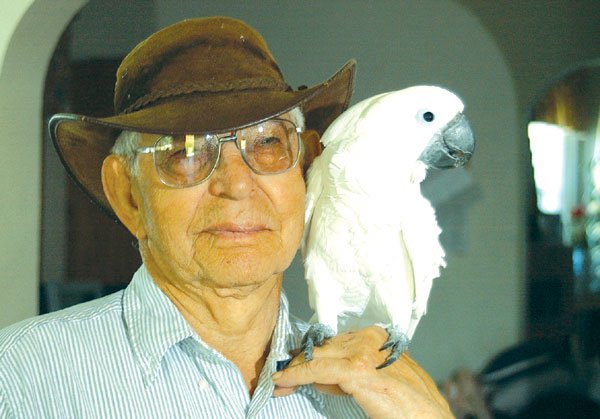San Martin
– In his 87 years, Sal Bravo has worked for Nobel Prize winning
scientists, designed machinery used worldwide, visited 64
countries, raised eight children and influenced dozens of people
along the way. And he doesn’t plan on stopping anytime soon.
San Martin – In his 87 years, Sal Bravo has worked for Nobel Prize winning scientists, designed machinery used worldwide, visited 64 countries, raised eight children and influenced dozens of people along the way. And he doesn’t plan on stopping anytime soon.
“Life’s a great big cake and I’m gonna eat it all,” he said, after spending the day working on his San Martin house where he has lived for 30 years.
A charismatic, good humored man, Bravo doesn’t look or act his age. He loves to tell stories full of dates, names and statistics, pulling out the books, newspaper articles and photos to back up his tales. If his wife or grandchildren aren’t around he can always share the stories with his umbrella cockatoo Paco, who laughs like his wife. Bravo has trained him to be polite and always tell pretty ladies “I love you”.
Born in Mexico, Bravo came to the United States with his family when he was 10 months old. He grew up in the San Joaquin Valley, milking cows and cultivating peas with his father for 15 cents an hour.
“If somebody had told me I’d have more money than I needed I wouldn’t have believed it,” he said. He keeps one of his first paychecks in his wallet to remind him of those days.
In his late teens he drove trucks but quickly realized he was better suited to build them. He always had an eye for machinery and could see how things should be built. From there he began designing other machinery for agriculture and transportation.
From 1954 to 1998 he worked for Stanford University as a design engineer.
The W. W. Hansen Laboratories at the University hired him to design and construct components of several machines, including a linear accelerator for observing matter at temperatures near absolute zero, and the Pion-Meson machine for treating cancer.
The head scientists for six projects he worked on received Nobel Prizes for their work.
“The physicists had so much faith in me they just told me what to do and I did it,” Bravo said.
While he did not have a formal education beyond sixth grade, he was allowed to attend any class during his 30 years at Stanford. He said he’s sat in enough lectures to have degrees in both geology and astronomy.
“I don’t have the paperwork, but I bet a lot of people would want to be in my shoes,” he explained. “I just wanted the information.”
Bravo also started his own manufacturing firm, Bravo Manufacturing Co., while working at Stanford. One of his company’s main projects was the design, engineering and production of a sterilization vessel that is currently in use worldwide. The machine uses radiation to sterilize food, spices and medicine.
While building machines and attending classes, Bravo met his current wife, Carol, while working at Stanford. He was 46 and she was 25.
“It wasn’t a problem, look at him,” she said. “I’m the one with arthritis.”
The two married in Mexico in 1967. They went from town to town until they found one fit for the celebration.
“We had a great reception with the people at the hotel,” she remembered.
At the time, he had five grown children from his first marriage and she had two young daughters.
They later legally adopted one of the grandsons. Now they have 15 grandchildren and 15 great-grandchildren.
“They get a kick out of him,” Bravo’s wife said. For his 80th birthday his family took him to a race track where he could get behind the wheel and show off his daredevil driving skills.
Over the years Bravo has taken up hunting and scuba diving, but his favorite thing to do is travel. He and his wife plan on visiting China next.
While his stories include elaborate descriptions, his reflection of the last eight decades is plain and simple.
“I’ve always been pretty lucky, that’s all,” he said, smiling contentedly.














